Azerbaijan In The Light Of Climate Change – Analysis
By CCEE
By Shahana Bilalova*
Background
Impact of climate change is felt all around the world and urges countries to take actions. Earlier this year, the European Union (EU) introduced its Green Deal- a growth strategy to turn the EU into climate-neutral by 2050 by transitioning into green economy. Meanwhile, in the United States, U.S. Democratic Rep. Alexandria Ocasio-Cortez and Democratic Sen. Ed Markey proposed the Green New Deal package to address climate change and to transform into 100 percent clean energy. With the global call for climate urgency backed up by scientific studies and climate activist movements all around the world, the issue was also integrated into the agenda of the recent World Economic Forum held in Davos in 2020.
Azerbaijan is no exception in this global climate action. Ratification of the UN Framework Convention on Climate Change (UNFCCC) in 1995 and joining Kyoto Protocol (2000) and Paris Agreement (2015) delegated certain obligations to Azerbaijan. Along with its commitment to reduce 35% of its greenhouse gas emission by 2030 under Paris Agreement, Azerbaijani government also intends to take actions to increase share of renewables in total electricity electricity production to 30% by 2030. The current policy brief aims at introducing current climate trends in Azerbaijan, existing legal and policy frameworks as well as analysis of the current pathway towards meeting its target.
Analysis
What Climate Change is
Climate change as defined by the Intergovernmental Panel on Climate Change (IPCC) (2018) is “a state of the climate that can be identified by changes in the mean and/or the variability of its properties and that persists for an extended period, typically decades or longer” and is attributable to natural variability or anthropogenic activities. Meanwhile, the definition offered by UNFCCC presents a clear distinction line between climatic changes caused directly and indirectly by human activities and variability caused by natural driving forces within general climate change phenomenon. Even though the driving factors behind climate change might differ ranging from natural to human based, the role of greenhouse gases (i.e. mainly carbon dioxide, methane and nitrous oxide) released through anthropogenic activities is immense and according to IPCC (2014) they are the most significant driving factor. To elaborate it more, generally greenhouse gases (GHG) exist in the atmosphere naturally and allow the Earth to keep its optimal temperature for habitation (King, 2005). However, once the limit is exceeded through accumulation of excessive amount of GHG due to the human- induced activities, more energy entering the Earth is trapped ending up in warming of land surface, oceans and atmosphere (Armstrong et al., 2018). Consequently, the process results in temperature rise, acidification, sea level rise, ice melting, local and regional weather changes, forest loss due to the wildfires, extreme weather events, water vaporing and biodiversity loss (Armstrong et al., 2018).
Global Climate Action Timeline
The following timeline illustrates the key events in the climate change history:
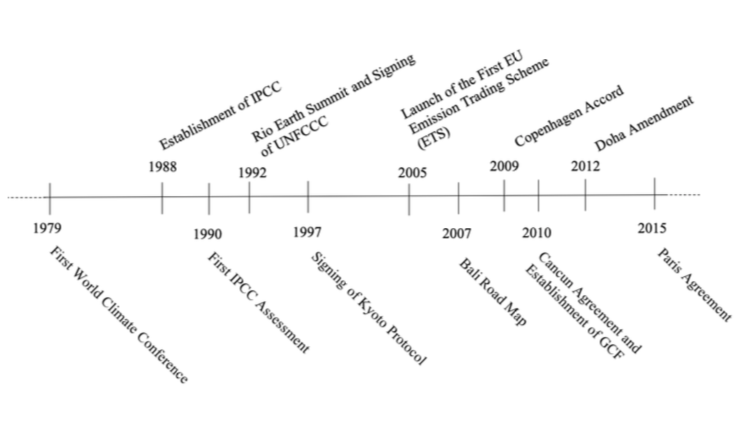
Climate Change Trends in Azerbaijan
The whole South Caucasus region, including Azerbaijan is very vulnerable towards ongoing climate change phenomenon captured in several research studies done previously. Based on the research conducted by Zoi Environment (ENVSEC, 2011), an analysis of the data from 1991 to 2000 identifies an increase of 0.41oC which is more than an increase detected for the period of 1961-1990. Furthermore, the same research also detects a decline in precipitation by 9.9% over the past ten years of the study period. Apart from the trends in temperature and precipitation, other components being vulnerable to the climate change are snow cover and glaciers which also demonstrate a certain variation pattern. The study conducted by Sylven et al (2018) detects an increase in snow line from 1300-1500 m to 1800-2000 m along with the 50 percent decline in glaciers in the South Caucasus region over the last decade.
It is essential to highlight the interconnected nature of the ecological system. Any change happening at one level certainly affects the components at other levels. Therefore, the changes highlighted above has a certain ripple effect that can be felt in other ecosystems. As an example, the changes in temperature and precipitation play a significant role in a hydrological regime that might threaten existing water resources and livelihood of people. This is also reflected in the case of Kura River due to the correlation between climatic indices and hydrology. Based on the study, the Kura River experiences a slight shift in its hydrological cycle due to the increasing trend in precipitation during the cold month which leads to early snow melt (Bilalova, 2019).
Based on the models (USAID, 2017), the situation is projected to intensify in the future with increased temperature, extreme weather events and sea level rise. This further threatens not only biodiversity but also people’s livelihood through water and food security, impact on health as well as national economy.
Corresponding Legislative and Policy Framework
Currently, there is a gap in legislative and policy framework concerning climate change. Climate change is mentioned in some strategic documents in a broad way such as “Azerbaijan 2020: Look into the Future” Concept of Development (i.e. acknowledgement of climate change and need for action) and Strategic Road Map for the Production and Processing of Agricultural Products in the Republic of Azerbaijan (i.e. addressing climate change in agricultural sector through reduction of CO2 emission and mechanism development for eliminating negative climate change impacts). Furthermore, an absence of mitigation strategies and adaptation planning in Azerbaijan is also a challenge in addressing the issue of climate change.
Despite climate change is not referred explicitly in the existing legislation, certain related aspects can be captured in the following documents: Law on Hydrometeorological activities (1998), Law on Environment Protection (1999), Law on Environmental Safety (1999), and Law on Protection of Atmospheric Air (2001).
On a global level, Azerbaijan being a party to several international environmental documents (e.g. Kyoto Protocol, Doha Amendment and Paris Agreement) has certain obligations to meet. Among these documents, the most important one to highlight is the submitted Intended Nationally Determined Contributions (INDC) report of Azerbaijan under the Paris Agreement (2015) within the United Nations Framework Convention on Climate Change (UNFCCC) aimed at tackling climate change. In this regard, according to the INDC report (2015) of Azerbaijan, taking 1990 as a base year, Azerbaijan targets a 35% reduction in its greenhouse gas emission (i.e. CO2, CH4, N2O, HFC, CF4) by 2030. In the respective report, sectors of energy, agriculture, waste, land use, land-use change, and forestry (LULUCF) are further highlighted in which certain actions are planned to be taken to ensure the targeted level of GHG emission mitigation. However, the document does not present any exact amount for reduction per sectors as well as timeline and planned action rather very general framework. More elaborated actions are highlighted in the subsequent national communications and reporting to the UNFCCC.
Azerbaijan’s Pathway Towards INDC
As mentioned previously, Azerbaijan pledged to reduce its emission by 35% by 2030 taking 1990 as a base year. To look into the depth of the GHG emission in the country for the period of 1990-2017, the biggest emitting sector is energy followed by agriculture, industry and waste (Figure 2). In this regard, in 2017 energy sector accounted for 75 percent of the whole GHG emission in the country while agricultural sector was responsible for 14 percent of it (Figure 1). The remaining portion of 11 percent was shared between industrial processes (6 %) and waste (5 %).
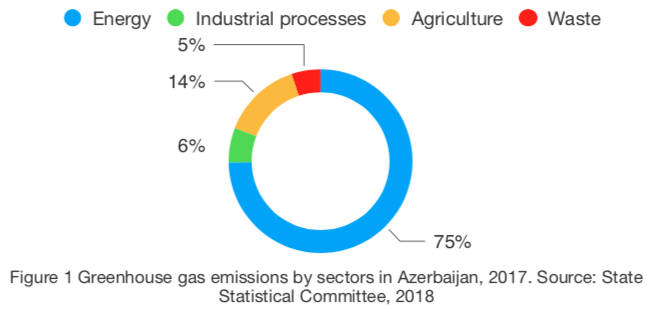
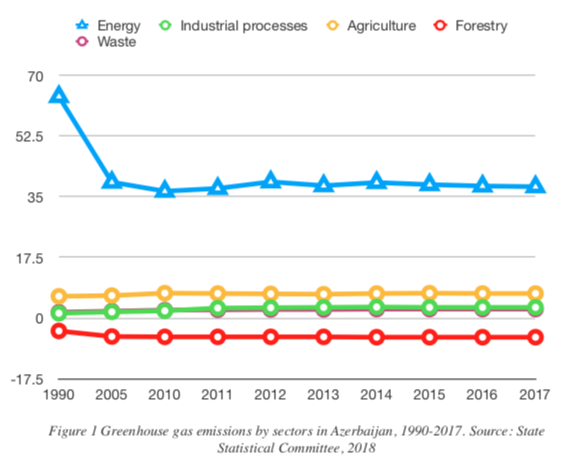
Generally, comparing the emissions per sectors for the base year and the last record year, only energy sector was able to achieve a reduction which was almost twofold decreasing emissions from 63.9 MMTCDE to 37.9 MMTCDE. This achievement was mainly attributable to the transformation of energy generating plants from heavy oil into gas consuming plants as a main energy source and increased energy efficiency over the years (Figure 3).
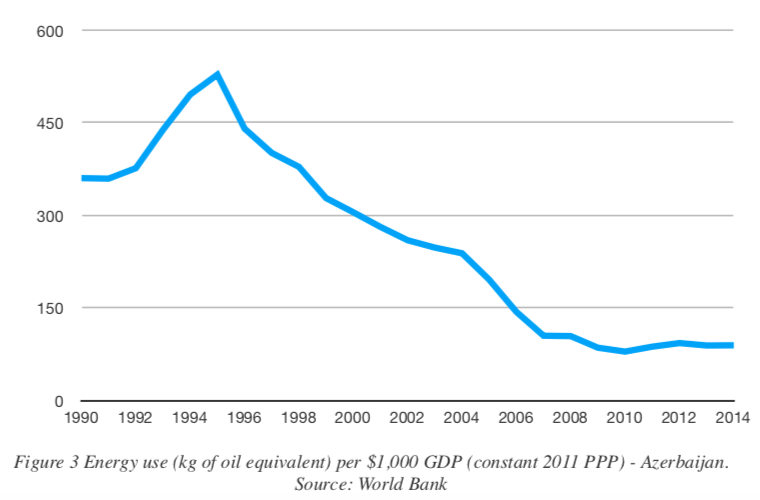
LULUCF was another sector contributed positively to the GHG absorption by increasing 1.5 times over 27 years. Meanwhile, the other sectors of industry, agriculture, waste experienced an increase of 2.2, 1.1, 1.5 times, respectively comparing the information of 2017 to 1990 base year (Figure 2). This negative trend is mainly linked to the increase in consumption followed by demand resulting from population growth over the years.
Now the question arises whether Azerbaijan is on the track concerning its 2030 target of 35% reduction. Looking at the base year and recent available data record (2017) from State Statistical Committee, the progress is captured as by 2018 reductions in total GHG emission excluding and including LULUCF were 30.8 % and 34.9%, respectively (Figure 4). Therefore, it can be claimed that Azerbaijan is doing well so far in terms of 35 percent reduction target. However, this success is mainly attributed to the chosen base year. Looking at the last ten years of 2007-2017, the reduction was only 7.1% while a sharp decline in GHG emission occurred from 1990 to 2000 due to the reasons mentioned above (Figure 4). Thus, while the target is more likely to be achieved, definitely more acute commitments are required to tackle climate change.
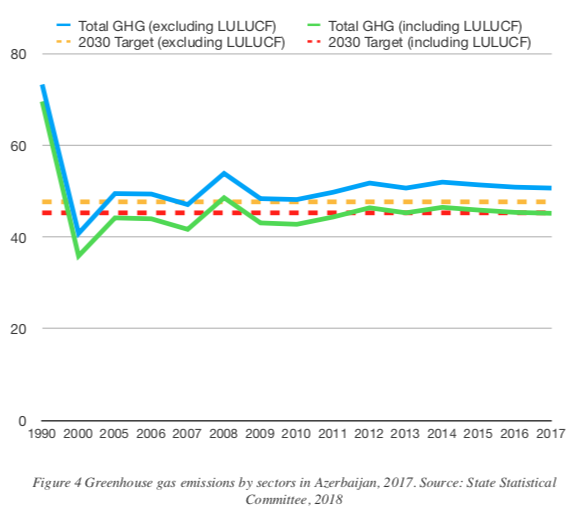
Recommendations
Climate change is a very complex issue in nature, thus all actions designed to address this problem should consider complexities involved. Considering the above-mentioned facts, the following policy recommendations are suggested to address the problem in the context of Azerbaijan:
1.Institutional arrangements for climate action through development of national action plan and resilience and adaptation strategies.
2.Assessing sectoral vulnerability towards climate change and designing transition plans for all sectors of Azerbaijan with the aim of reducing emissions.
3.Facilitation of low-carbon transition through fiscal incentives (i.e. taxation, subsidies, investments and financing) and policy alignments.
4.Decarbonization of the energy system, enhancing energy efficiency and expanding and upgrading the deployment of renewable energy sources.
5.Mainstreaming climate policy into existing national policy and development plans.
6.Designing a coordination mechanism to ensure cross- sectoral and cross-scale data and knowledge sharing and interaction.
7.Enhancing finance into Research and Development (R&D) to foster expansion of clean technologies and production in the economy.
8.Engaging private sector into mitigation and adaptation process through public-private partnership, financial instruments and technical assistant.
9.Ensuring local knowledge and participation as a part of adaptation strategy.
10.Promotion of community-based adaptation strategies.
11.Fostering climate related education, awareness raising, institutional strengthening and capacity-building.
*About the author: Shahana Bilalova, Research Associate, Caspian Center for Energy and Environment at ADA University
Source: This article was published by Caspian Center for Energy and Environment (CCEE) of ADA University as CCEE Policy Brief April 2020 | No.36 (PDF)
References:
Armstrong, A., Krasny, M., & Schuldt, J. 2018. Climate Change Science: The Facts. In Communicating Climate Change: A Guide for Educators.7-20. London: Cornell University Press.
Bilalova, S. 2019. Assessment of the Impacts of Climate Change on the Hydrology of the Kura River Basin. Master of Science thesis, Central European University, Budapest. Information to the United Nations Framework Convention on Climate Change (UNFCCC) on the Intended Nationally Determined Contribution (INDC) of the Republic of Azerbaijan. 2015. Retrieved from https:// www4.unfccc.int/sites/ndcstaging/ PublishedDocuments/Azerbaijan%20First/ INDC%20Azerbaijan.pdf
IPCC, 2018: Annex I: Glossary [Matthews, J.B.R. (ed.)]. In: Global Warming of 1.5°C. An IPCC Special Report on the impacts of global warming of 1.5°C above pre-industrial levels and related global greenhouse gas emission pathways, in the context of strengthening the global response to the threat of climate change, sustainable development, and efforts to eradicate poverty [Masson-Delmotte, V., P. Zhai, H.-O. Pörtner, D. Roberts, J. Skea, P.R. Shukla, A. Pirani, W. Moufouma-Okia, C. Péan, R. Pidcock, S. Connors, J.B.R. Matthews, Y. Chen, X. Zhou, M.I. Gomis, E. Lonnoy, T. Maycock, M. Tignor, and T. Waterfield (eds.)]. In Press
King, D. 2005. Climate Change: The Science and the Policy: Climate Change: Science and Policy. Journal of Applied Ecology 42 (5): 779–83.
Sylvén, M., Reinvang, R., and Andersone-Lilley, Z. 2008. Climate Change in Southern Caucasus: Impacts on nature, people and society. WWF Norway.
The Environment and Security Initiative (ENVSEC). 2011. Climate Change in the South Caucasus: A visual synthesis. Zoï Environment Network.
USAID. 2017. Climate Change Risk Profile: Azerbaijan. Retrieved from https://www.climatelinks.org/sites/default/ files/asset/document/ 2017_USAID_Climate%20Change%20Risk%20Profile_Azer baijan.pdf.

